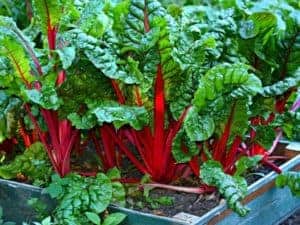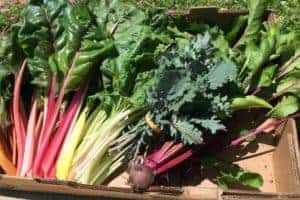 Swiss chard is one of the most underrated vegetables you can grow. It’s hardy, tolerant of frost and hot temperatures, and very easy to grow even for a beginner. You can grow Swiss chard for the leaves or the stalks; the leaves have a mild, spinach-like flavor whereas the stalks have an earthy taste like beets – beets and chard are both in the same family.
Swiss chard is one of the most underrated vegetables you can grow. It’s hardy, tolerant of frost and hot temperatures, and very easy to grow even for a beginner. You can grow Swiss chard for the leaves or the stalks; the leaves have a mild, spinach-like flavor whereas the stalks have an earthy taste like beets – beets and chard are both in the same family.
The Swiss chard in the supermarket usually has red stalks and veins, but it comes in many varieties with pink, orange, green, purple, and white stalks. And Swiss chard doesn’t easily bolt (form a flower stalk) unlike other leafy greens. When green vegetables like lettuce and spinach bolt, it’s basically over for them as they focus on seed production and have super bitter leaves.
Benefits of Growing Your Own Swiss Chard
1. The most important benefit of growing your own Swiss chard is that you know exactly what went into growing it and can avoid any use of chemical pesticides, fungicides, and herbicides. The Environmental Working Group puts out a list every year of the most pesticide-laden fruits and vegetables (link: https://www.ewg.org/foodnews/summary.php), and popular leafy greens always top the list.
“You can eat both the stems and leaves of Swiss chard, and they both have a different flavor and can be used in various dishes.”
One of the lesser-known benefits of growing Swiss chard or any vegetable at home is avoiding contaminated food scandals. Every week, somewhere in the country is a food recall. Leafy green salad bags are often at the top of the list due to the way they’re processed and packaged, often combining vegetables from many different farms. All it takes is one tainted crop from one farm to ruin the whole batch.
2. With Swiss chard, you get two vegetables in one. You can eat both the stems and leaves of Swiss chard, and they both have a different flavor and can be used in various dishes. The leaves make a great spinach substitute, fresh or cooked. There is a vegetable called Perpetual Spinach, which is just a variety of chard with pointier leaves, green stems, and a stronger spinach flavor. Why grow Swiss chard instead of spinach? Spinach is strictly a cold-weather crop, and will quickly bolt in the summer, ruining the taste. But Swiss chard, while it tastes best in cool weather, can sometimes grow all year long without bolting.
The leaves can be used in salads, soups, stir fries, cooked with eggs, or any other way you’d use spinach. The stems can be used in stir fries, soups, or can add extra color to your salads. The stems can also be a fun alternative to celery sticks, coming in a wide array of colors. Sometimes I like to steam or stir fry them both together.
3. Homegrown Swiss chard is always cheaper than store-bought. Even if you don’t buy organic, it can still be cheaper to grow Swiss chard at home. Once you have your garden set up, all you need to do is buy seeds and some fertilizer. And if you make your own compost and save your own seeds, the only cost is your time and labor, which is almost nothing when growing an easy vegetable like Swiss chard.
Growing your own Swiss chard is economical even in the best of times, but after COVID-19, there’s been a lot of concern about the food supply chain and rising grocery bills. Growing your own food in general is a great hedge (no pun intended) to the volatility of the food supply. Rice, beans, flour, etc. will likely still be very cheap in the long run, but easily perishable foods like green vegetables will only continue to go up in price. By the way, as a gardener you will also save money by saving your own seeds. Let one or two of your Swiss chard plants continue to grow until they produce a flower stalk and you won’t have to worry about widespread “seed shortages” like in early 2020.
 4. Swiss chard grown at home is more flavorful and even more nutritious than what you can buy at the supermarket. Everyone says homegrown vegetables taste better, but is that true? For ripening fruits, the answer is obviously yes. But even for leafy green vegetables that’s the case. There are a few factors that affect flavor. One is the temperature. Chard is delicious any time of the year, but is especially mild in the spring and fall, almost becoming a little sweet in late fall. Another factor is freshness, and nothing is fresher than something you just cut that morning. And that brings me to a not-so-secret tip in the gardening world: the best time to harvest leafy greens of any kind (Swiss chard, kale, lettuce, spinach, etc.) is early in the morning before the midday heat sets in. It’s perfectly fine to harvest later, but you really do get the best taste when cutting them right around sunrise.
4. Swiss chard grown at home is more flavorful and even more nutritious than what you can buy at the supermarket. Everyone says homegrown vegetables taste better, but is that true? For ripening fruits, the answer is obviously yes. But even for leafy green vegetables that’s the case. There are a few factors that affect flavor. One is the temperature. Chard is delicious any time of the year, but is especially mild in the spring and fall, almost becoming a little sweet in late fall. Another factor is freshness, and nothing is fresher than something you just cut that morning. And that brings me to a not-so-secret tip in the gardening world: the best time to harvest leafy greens of any kind (Swiss chard, kale, lettuce, spinach, etc.) is early in the morning before the midday heat sets in. It’s perfectly fine to harvest later, but you really do get the best taste when cutting them right around sunrise.
Homegrown Swiss chard is also more nutritious. Swiss chard is loaded with vitamin A and C (just two cups will give you 90% of your daily recommended vitamin A!) and has a variety of other micronutrients. Since you can choose the growing conditions and what fertilizer to use, you can ensure your plants will grow healthy and have all the minerals it needs which in turn you and your family will be eating. Compost is ideal, but a balanced organic fertilizer or a liquid fertilizer loaded with micronutrients will ensure you can get something even more nutritious than what you normally buy.
